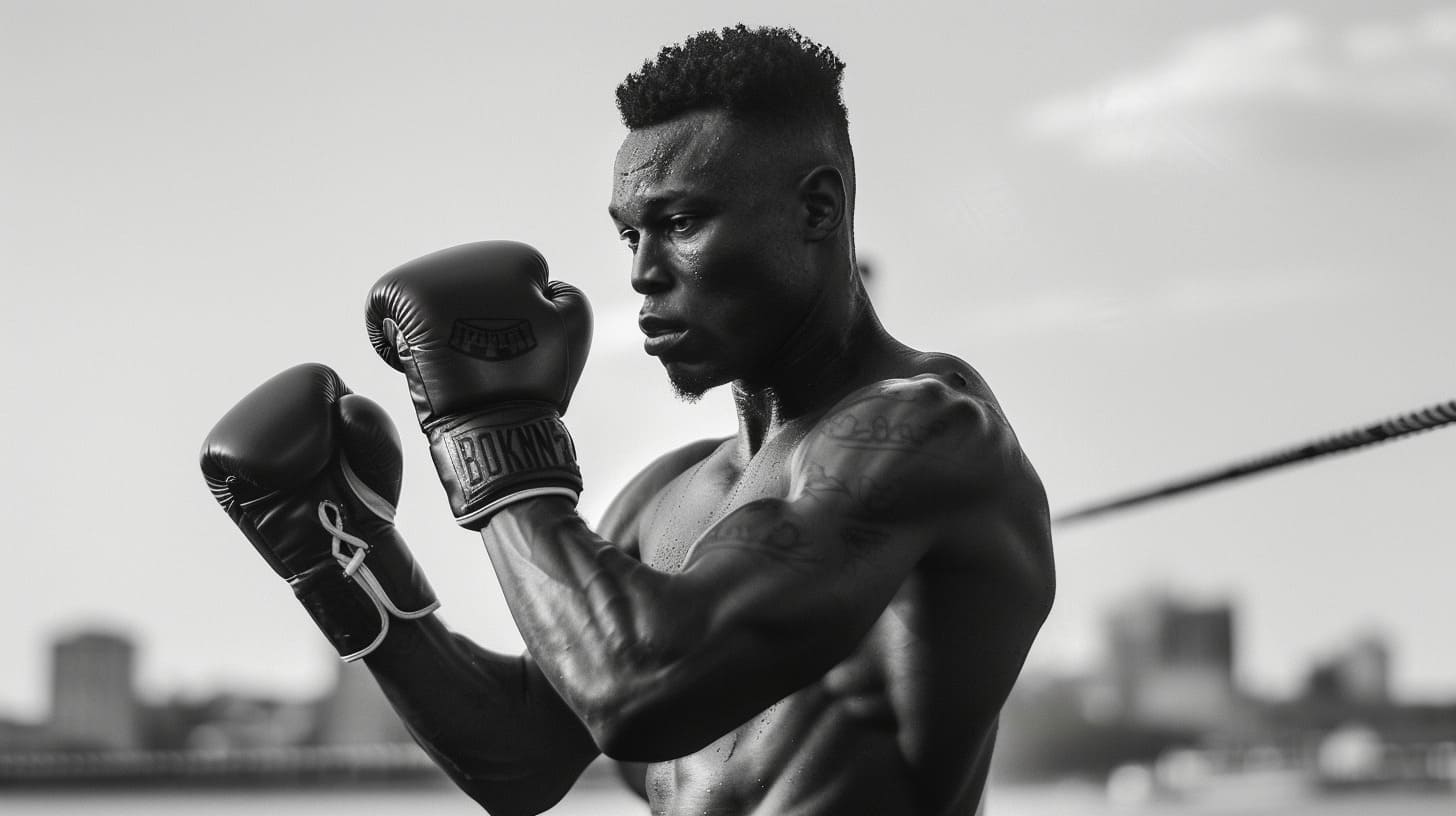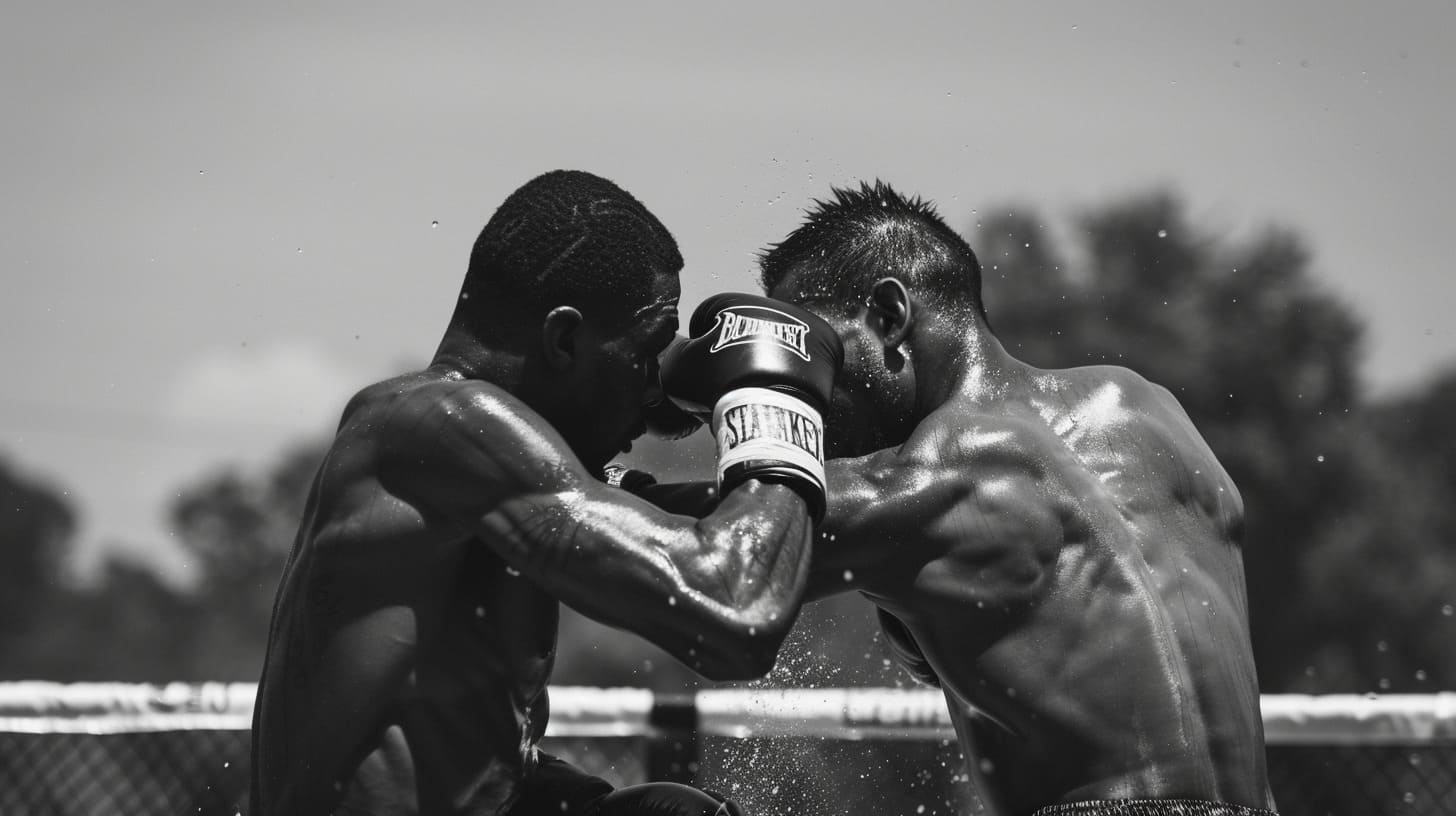The Philly Shell boxing style, a slick defensive technique popularized by legends like Floyd Mayweather Jr., fundamentally transforms a boxer’s stance and approach to both offense and defense. Engaging and elusive, this method utilizes shoulder rolls and tight guard positioning to deflect punches and create counter-attack opportunities, becoming the hallmark of many boxing greats who value finesse over brute force. With its strategic use of body movement and calculated efficiency, the Philly Shell epitomizes the sweet science of boxing.
What Is Philly Shell Boxing Style?
Picture this: You’re watching a boxing match, and one fighter seems almost untouchable—slipping punches with an effortless swagger, shoulder rolling off attacks. Chances are, you’re witnessing the art of the Philly Shell.
The Basics of Philly Shell
At its core, the Philly Shell is a defensive boxing style that prioritizes protection while setting up effective counterattacks. It’s like a suit of armor mixed with a spring-loaded trap—here’s how:
- Stance: The boxer stands with the left foot forward, body turned slightly to present a smaller target.
- Guard: The lead arm (usually the left) is held across the torso, the hand near the opposite hip to defend the body. The rear hand is up by the face to protect the chin, and the lead shoulder is raised to shield the jaw and neck.
- Footwork: There’s a fluid, bouncing rhythm that Philly Shell boxers maintain, ready to pivot and roll with incoming strikes.
Unique Techniques of the Philly Shell
While the visuals are cool, it’s the unique techniques that truly set the Philly Shell apart:
- Shoulder Roll: This is the signature move. As punches come in, the boxer rolls the lead shoulder to deflect them, minimizing damage.
- Pull Counter: When an opponent punches, the Philly Shell boxer pulls back to let it whiz by, then snaps a counterpunch.
- Catch and Shoot: Using the rear hand, the boxer ‘catches’ an incoming punch then ‘shoots’ back with their own strike.
Distinct Footwork and Rhythm
Footwork in the Philly Shell is not about wild leaps or dramatic lunges; it’s about:
- Small, calculated steps to maintain ideal distance
- Quick pivots to change angles and avoid being cornered
- Syncing movements with the opponent, creating a reactive dance that baffles and frustrates the attacker
How It Stands Out
Comparing the Philly Shell to conventional boxing techniques reveals its distinct nature:
| Philly Shell Style | Conventional Boxing Techniques |
|---|---|
| Defensive and counter-heavy | Often a more balanced mix of offense and defense |
| Specific stance and guard | Varies more widely between fighters |
| Emphasis on rolling and slipping punches | Generally more reliant on blocking and parrying |
In a nutshell, the Philly Shell is characterized by a strategic blend of sleek defense with clever offense. It’s not just about surviving the round—it’s about controlling it, making the opponent play your game, and seizing opportunities they didn’t even know they were giving you. This boxing style requires patience, precision, and plenty of practice, but mastering it can turn fighters into true ring tacticians.
Signature Moves & Strategies of the Philly Shell Boxing Style

The Philly Shell Strategy
Ever wondered what makes the Philly Shell boxing style so distinct and effective? Let’s delve into some top-tier tactics that give fighters using this style an edge in the ring.
1. The Shoulder Roll
This smooth defensive move is all about finesse and timing. Boxers using the Philly Shell typically lean back slightly, raising the front shoulder to deflect incoming punches. It’s like they’re saying, “Nice try!” to their opponent without uttering a word.
- Purpose: Minimizes damage, conserves energy.
- Effect: Throws off the opponent’s rhythm.
- Example: Floyd Mayweather Jr., a virtuoso of the Philly Shell, often left his adversaries swinging at air with his impeccable shoulder roll technique.
2. The Lead Right Counter
When executed with precision, this counterpunch can catch an opponent off-guard and shift the momentum of the bout. From their defensive posture, the boxer quickly uncorks a lead right hand.
- Purpose: Deliver a surprising counter strike.
- Effect: Can stun or knock down an opponent.
- Example: James Toney mastered this rapid-fire counter, often turning the tables on his opponents when they least expected it.
3. The Pull Counter
This strategy combines both offense and defense in a seamless dance. As a punch comes in, the boxer in the Philly Shell stance pulls their head back to evade the blow, then springs forward with a counterattack.
- Purpose: Evade and immediately retaliate.
- Effect: Keeps opponents wary of attacking.
- Example: Bernard Hopkins employed the pull counter to great effect, coupling his defensive savvy with well-timed offense to secure wins against younger, aggressive fighters.
Understanding these signature Philly Shell moves illuminates why this style is so revered. It’s not just about looking cool; it’s a strategic fortress of defense coupled with sharp, retaliatory offense. The legends of the sport who’ve adopted this style weren’t just showing off—they were showcasing a refined craft that takes years to perfect.
Challenges and Limitations of the Philly Shell Boxing Style

So, the Philly Shell looks cool — we get it. Mayweather made it look like a walk in the park, but don’t be fooled; it’s not all smooth sailing with this defensive stance.
The Benefits of the Philly Shell Boxing Style
There are plenty of moments in the ring when using the Philly Shell boxing style feels like you’ve got a secret weapon at your disposal. But remember, it’s all about timing and knowing when it shines the brightest. Here are some scenarios where the Philly Shell style can give you a distinct edge:
- When Counterpunching: It’s perfect for setting up sharp counterpunches. With your lead shoulder raised, you can quickly snap back into place for a fast counter.
- Against Straight Punches: This style excels at neutralizing jabs and straight rights. It’s all about that shoulder roll, baby!
- To Conserve Energy: Less movement means you’re saving energy for when you really need to turn up the heat.
- In Close Quarters: Fighting up close? The shell protects your vitals while allowing you to work your opponent’s body.
- When Setting Traps: It’s a great way to bait your opponent into making a mistake. Show them a target, then take it away!
This strategy, when employed correctly, can really take your opponent off-guard and give you the upper hand.
The Drawbacks of the Philly Shell Boxing Style
But hey, not every day’s a sunny one, even with the Philly Shell. It’s not a one-size-fits-all solution and there are times when you might find yourself wishing you’d gone with good ol’ guard. Take a look at these situations where the style might backfire:
- Facing Aggressive Swarming: Swarming fighters can overwhelm the Philly Shell with sheer volume, finding ways around your defense.
- Against Southpaws: The angles are all wrong here, folks. Southpaws can exploit the open side of a right-handed Philly Shell stylist like no tomorrow.
- When Cornered: If you’re trapped against the ropes or in a corner, the Philly Shell can leave you with fewer options to escape.
- Versus Body Punchers: A crafty body puncher can slide punches under your leading arm. So, watch your ribs!
- Lack of Footwork: If you’re not light on your feet, you may find yourself a sitting duck. This style depends on slick movement to be effective.
Remember, while the Philly Shell can be a great part of your boxing arsenal, it’s not without its weaknesses. It’s essential to mix it up and keep evolving your style to stay one step ahead of the competition. Always keep your tactics as versatile as your footwork, and you’ll stay dancing in the ring longer.
Defending Against Philly Shell Boxing Style

So, you’ve come face-to-glove with the elusive Philly Shell style in the boxing ring. In a nutshell, this defensive technique can be a tough nut to crack, but with the right strategies, you can fight back effectively.
What Makes the Philly Shell Tricky to Combat?
This style, mastered by legends like Floyd Mayweather Jr., boasts a tight defense, sneaky counterpunching, and can be incredibly frustrating for an orthodox fighter to penetrate. The stance reduces the target area and uses the lead shoulder to deflect punches, making traditional combos less effective. But don’t throw in the towel just yet! We’ve got some practical know-how to share that can help you land those punches without getting countered into next week.
- Stay Patient and Disciplined: Overcommitting is what a Philly Shell boxer wants you to do. Keep your cool and don’t rush in.
- Target the Body: The high guard used in the Philly Shell can leave the torso exposed. Aim lower to score points and potentially lower your opponent’s guard.
- Use Feints: Trick your opponent into committing to a counter-position by faking punches. This can open up real opportunities for you to exploit.
- Mix Up Your Attack Angles: Throw punches from different angles, especially looping shots around the opponent’s guard and uppercuts under it.
- Stay on the Move: Keep changing your position to force the Philly Shell boxer to adjust their stance and openings may appear.
Additional Practical Tips:
- Engage in Close Quarters: When you get up close and personal, it’s harder for the Philly Shell practitioner to use their shoulder roll effectively.Getting inside the Philly Shell means your opponent has less room to maneuver and counterpunch. It’s a space where you can work your magic, especially with hooks and uppercuts that can slip through their defenses.
- Apply Consistent Pressure: Keeping your foot on the gas can fatigue a Philly Shell boxer and cause them to make mistakes.Consistently advancing and putting pressure on a Philly Shell fighter can disrupt their rhythm. It’s like a ticking clock; eventually, time runs out, and an opening will present itself for a well-placed punch.
- Utilize the Jab Wisely: While the jab can be neutralized by a Philly Shell defense, it can still be used to set up more effective punches.Think of your jab as the key that can unlock the door to a Philly Shell boxer’s defense. Use it not just to hit, but to blind, distract, and set up your power shots.
Remember, each fighter is different, and these tips are starting points. It’s essential to adapt to the situation in the ring and find what works best against your particular Philly Shell-wielding opponent. Keep your gloves up, your head on a swivel, and your strategy adaptable. Good luck, and may your punches land true!
Notable Practitioners
Discovering the Philly Shell defense in boxing is like unwrapping a part of the sport’s rich history. This distinctive style has been used by some of the most skillful fighters in the ring. Let’s highlight three legendary boxers who have not only mastered it but also left an indelible mark through their illustrious careers.
Floyd Mayweather Jr.
Starting with none other than Floyd “Money” Mayweather Jr., his name often surfaces when discussing the Philly Shell or Shoulder Roll. Mayweather refined this technique, transforming defense into an art form.
- Career Highlights:
- Undefeated professional record of 50-0
- Multiple world titles across different weight classes
- Recognized as one of the greatest boxers of all time
- Contribution to Philly Shell Legacy:
- Elevated the style with his impeccable timing and precision
- Became a blueprint for aspiring boxers wanting to learn the Philly Shell
- Memorable Moment:
- His clinical dismantling of Arturo Gatti in 2005, where his Philly Shell defense was on full display.
James Toney
Moving on, James “Lights Out” Toney is another maestro of the Philly Shell. His version of the defense was coupled with counter-punching prowess that left opponents baffled.
- Career Highlights:
- Champion in multiple weight divisions including middleweight and cruiserweight
- Known for his defensive skills and ring IQ
- Contribution to Philly Shell Legacy:
- Showed the effectiveness of the Philly Shell against power punchers
- Influenced the defensive strategies of future generations
- Memorable Moment:
- His fight with Iran Barkley in 1993, where Toney’s Shell was instrumental in securing the IBF Super Middleweight title.
Bernard Hopkins
Finally, Bernard “The Executioner” Hopkins, a tactician in his own right, demonstrated that the Philly Shell could be effective well into the later years of a boxer’s career.
- Career Highlights:
- One of the most successful middleweight champions in history
- Longevity in the sport with significant wins well past the age of 40
- Contribution to Philly Shell Legacy:
- Used the Philly Shell to augment his strategic approach to boxing
- Proved that age is just a number with the right technique and conditioning
- Memorable Moment:
- His historic victory over Jean Pascal in 2011, becoming the oldest world champion in boxing history at age 46, showcasing the Philly Shell.
These fighters are testament to the effectiveness and allure of the Philly Shell style. They’ve used this defensive technique to carve their names in the annals of boxing history, inspiring many to study and adopt this approach. Each has faced different opponents, overcome unique challenges, and left a legacy that will influence boxers for generations to come.
Training and Conditioning for the Philly Shell Boxing Style

The Philly Shell Strategy
Stepping into the ring with the Philly Shell boxing style can feel like stepping into a fortress, where defense and smart counters are your stone walls and battlements. But before you start shimmying and rolling like the pros, you’ve got to build your body and mind to suit the Philly Shell’s unique demands. Let’s dive into some proven exercises and strategies that will prepare you to adopt this stylish and effective boxing stance.
Drills to Master the Philly Shell Stance
Getting your drills right is like finding the perfect sparring partner, it can make all the difference. Here are some key drills to polish your Philly Shell technique:
- Shoulder Roll Drills:
- Stand in front of a mirror maintaining the Philly Shell stance.
- Practise rolling your shoulder to deflect incoming jabs and crosses.
- Stay relaxed and work on the timing to allow the punches to ‘roll’ off your shoulder.
- Counter-Punching Drills:
- Work with a partner or coach who throws slow punches towards you.
- Focus on using minimal movement to avoid the punch and immediately counter with a shot.
- Emphasize speed and precision in your counter-attacks.
- Footwork Drills:
- Use ladder drills to enhance agility and movement.
- Incorporate side-to-side, in-and-out, and pivoting motions that mirror the footwork used in the Philly Shell.
Exercises Tailored to the Philly Shell Style
Engaging the right muscles and building the necessary endurance is crucial. Here are exercises to condition your body specifically for the Philly Shell style:
- Core Strengthening: A strong core helps with balance and power in counter-punching.
- Planks
- Russian twists
- Medicine ball slams
- Shoulder and Neck Strengthening: These muscles are vital for maintaining the Philly Shell guard and absorbing impacts.
- Shoulder presses
- Shrugs
- Neck bridges
- Leg Workouts: Power comes from the ground up, and strong legs give you a solid foundation.
- Squats
- Deadlifts
- Jump rope for coordination and footwork
By integrating these exercises into your regular workout routine, you’re setting up the physical framework needed to execute the Philly Shell effectively.
Key Strategies for Peak Performance
Lastly, here’s a list of additional tips to keep in mind as you work towards mastering this boxing style:
- Stay Relaxed: Tension is the enemy of the Philly Shell. Practice staying cool under pressure.
- Focus on Defense: The Philly Shell relies on a tight defense; make it your priority during sparring.
- Watch the Greats: Study footage of boxers who excelled in the Philly Shell to see it in action.
- Mental Discipline: Develop the focus required to make split-second decisions in defense and counter-attack.
- Regular Sparring: There’s no substitute for real experience. The more you spar, the more instinctive the Philly Shell style will become for you.
Incorporating these strategies and exercises will help you build a solid foundation for the Philly Shell style. It’s a journey that requires patience and dedication — but with each training session, you’re one step closer to embodying the art of the Philly Shell in the ring. Keep pushing, stay focused, and enjoy the process.
Final Thoughts
As we lace up our gloves and prepare to step out of the ring, let’s reflect on the Philly Shell boxing style’s masterful blend of defense and countering precision. This style’s not just a showy dance around the ring—it’s an intelligent game of chess played at lightning speed. By studying the legends, dissecting the techniques, and understanding its strengths and potential pitfalls, any boxer can appreciate the sophistication that the Philly Shell brings to the sweet science. Whether you’re an aspiring fighter aiming to emulate Mayweather’s finesse or a seasoned combatant looking to add another layer to your defensive repertoire, the Philly Shell reminds us that boxing is as much about brains as it is about brawn. So, keep those shoulders rolling, those counters sharp, and maybe, just maybe, you’ll find yourself writing your own chapter in the annals of boxing history.
Additional Resources to Master the Philly Shell
So, you’re intrigued by the slick defense and strategic counter-punching of the Philly Shell style? To deepen your understanding and maybe even master this iconic boxing technique, I’ve gathered some top-notch resources that’ll give you a leg up. These materials range from insightful reads to engaging visuals that will help you grasp the Philly Shell like a pro.
Books to Get You Guarded Up
- “The Art of Boxing: Your Guide to the Sweet Science” by Bobby Mayne — While it covers more than just the Philly Shell, this book breaks down various techniques that can complement the Philly Shell approach.
- “Boxing’s Ten Commandments: Essential Training for the Sweet Science” by Alan Lachica and Doug Werner — Fundamental drills that could improve your Philly Shell stance are part of this comprehensive training manual.
Essential Articles for the Sweet Science Scholar
- ExpertBoxing’s Guide to the Philly Shell Defense — A detailed article that explains the mechanics and concepts behind the Philly Shell.
- The Boxing Tribune’s Breakdown of the Philly Shell – An article that provides a historical and technical look at the style and its use by famous boxers.
Videos to Visualize Victory
- YouTube: A search for “Philly Shell tutorial” will bring up multiple instructional videos. Channels like FightTips or Precision Striking often provide quality content, but be sure to check their credibility and coaching experience.
- TedTalks on Boxing Strategy: While not specific to the Philly Shell, these can offer insights into the strategic mindset needed for mastering this defense-oriented style.
Websites to Weave Through Your Opponent
- BoxRec – Not a Philly Shell resource per se, but understanding the careers and fights of boxers who’ve successfully employed this style, like Floyd Mayweather, can be invaluable.
- Sneak Punch’s Boxing Guides – A resource-rich site that often touches upon various boxing styles, including defensive techniques, which could supplement Philly Shell strategies.
Documentaries and Training Guides to Duck and Dive Deeper
- “Counter Punch” on Netflix — This documentary, while not exclusively about the Philly Shell, offers a look into the lives of boxers which can be useful for understanding the mindset.
- Title Boxing’s Instructional DVDs — They offer a range of training guides that occasionally delve into defensive boxing styles like the Philly Shell.
Remember, these resources are just starting blocks to enhance your Philly Shell technique. Practice, patience, and perhaps even a qualified coach can take you from being intrigued to in-command with the Philly Shell Boxing Style. Lace up your gloves and get ready to roll with the punches—as you dive into these resources, you’re bound to come out stronger and more knowledgeable on the other side.

